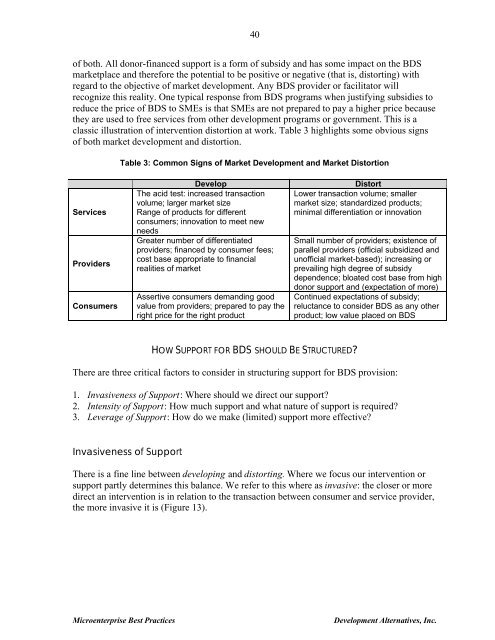BDS market development guide.pdf - PACA
BDS market development guide.pdf - PACA
BDS market development guide.pdf - PACA
You also want an ePaper? Increase the reach of your titles
YUMPU automatically turns print PDFs into web optimized ePapers that Google loves.
40<br />
of both. All donor-financed support is a form of subsidy and has some impact on the <strong>BDS</strong><br />
<strong>market</strong>place and therefore the potential to be positive or negative (that is, distorting) with<br />
regard to the objective of <strong>market</strong> <strong>development</strong>. Any <strong>BDS</strong> provider or facilitator will<br />
recognize this reality. One typical response from <strong>BDS</strong> programs when justifying subsidies to<br />
reduce the price of <strong>BDS</strong> to SMEs is that SMEs are not prepared to pay a higher price because<br />
they are used to free services from other <strong>development</strong> programs or government. This is a<br />
classic illustration of intervention distortion at work. Table 3 highlights some obvious signs<br />
of both <strong>market</strong> <strong>development</strong> and distortion.<br />
Table 3: Common Signs of Market Development and Market Distortion<br />
Services<br />
Providers<br />
Consumers<br />
Develop<br />
The acid test: increased transaction<br />
volume; larger <strong>market</strong> size<br />
Range of products for different<br />
consumers; innovation to meet new<br />
needs<br />
Greater number of differentiated<br />
providers; financed by consumer fees;<br />
cost base appropriate to financial<br />
realities of <strong>market</strong><br />
Assertive consumers demanding good<br />
value from providers; prepared to pay the<br />
right price for the right product<br />
Distort<br />
Lower transaction volume; smaller<br />
<strong>market</strong> size; standardized products;<br />
minimal differentiation or innovation<br />
Small number of providers; existence of<br />
parallel providers (official subsidized and<br />
unofficial <strong>market</strong>-based); increasing or<br />
prevailing high degree of subsidy<br />
dependence; bloated cost base from high<br />
donor support and (expectation of more)<br />
Continued expectations of subsidy;<br />
reluctance to consider <strong>BDS</strong> as any other<br />
product; low value placed on <strong>BDS</strong><br />
HOW SUPPORT FOR <strong>BDS</strong> SHOULD BE STRUCTURED?<br />
There are three critical factors to consider in structuring support for <strong>BDS</strong> provision:<br />
1. Invasiveness of Support: Where should we direct our support?<br />
2. Intensity of Support: How much support and what nature of support is required?<br />
3. Leverage of Support: How do we make (limited) support more effective?<br />
Invasiveness of Support<br />
There is a fine line between developing and distorting. Where we focus our intervention or<br />
support partly determines this balance. We refer to this where as invasive: the closer or more<br />
direct an intervention is in relation to the transaction between consumer and service provider,<br />
the more invasive it is (Figure 13).<br />
Microenterprise Best Practices<br />
Development Alternatives, Inc.














